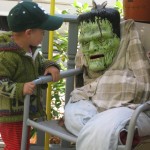Halloween EQ: Being Sensitive to Others
- Dr Laura Hutchison

- Oct 26, 2019
- 3 min read
Since Halloween is less than a week away, I thought it was the PERFECT time to discuss the importance of being mindful about children’s feelings. Actually, ANYTIME is good to discuss this .. but I have a couple of points to make for this specific time of year.

Here is a quick sensitivity training to help Raise Your & Your Child’s Halloween EQ (Emotional Intelligence):
1. Don’t force a child to do something they are afraid of. I think of this as a way of adults (and kids) bully children. (“What are you a wimp? Chicken? BokBok!” I can’t believe you’re scared of this.”) If your child is afraid of going to haunted house, spooky corn maze, or even up to a neighbor’s door … don’t force them. Listen to their concerns. Reflect that you hear what they are saying. Help them by trying to name the feeling (“You look pretty frightened.”) You can try to coach them through facing their fear … but don’t force them.
Forcing them will send the message that their feelings don’t count, that they shouldn’t listen to their own feelings, that if they try to stand up for themselves they will be ridiculed, and that this behavior is acceptable (i.e. if mom/dad does this to me, than it’s ok for me to treat others that way).
2. Prepare your child. Keep your child informed; let them know what to expect. Tell them how the day will unfold (“You’ll go to school in your costume. You’ll have a costume parade and a party there. And after dinner we will go trick or treating in the neighborhood”). Also, talk to them about costumes, masks, and make-up. Discuss that it is like a big game of pretend or dress up … people like to dress up cute or silly or scary. Visit a store that sells a variety of costumes and maybe try on a few masks with them to help young children (2 to 5 years) understand.
Many times parents forget this important step … and them expect children to be prepared on their own. Keeping them “in the loop” can help prevent some meltdowns and also gives them the opportunity to practice self-talk and mentally preparing for the day ahead.
3. Practice. Boy, do I wish I did this with my son! I think he was 3 … and very confident. I (wrongly) assumed that he remembered the whole trick-or-treat drill from the previous year. At first it went great … walked up to the house, yelled “Trick or Treat”, but then … when the neighbor opened the door, he went inside. Which makes perfect sense … on almost any other day when you go to someone’s house and they open the door you go inside. He was upset and confused at why this wasn’t ok (He really wanted to stay!) … and it was a bit stressful/embarrassing for me.
All of that confusion (even though now it’s a cute and funny story), could have been eliminated if we just rehearsed the process of trick or treating a few times. The same goes for practicing a Halloween parade or party.
4. Recognize facial cues. Halloween is an excellent opportunity for children to practice reading the nonverbal signals from others. During this time of year it’s particularly important to notice what it looks like when someone is scared. Helping children understand this can enable them to know when to stop if they are really terrifying another child. Being scary is okay, but understanding that if a smile doesn’t come soon after the frightened look it was probably a bit too much for the receiver. Unless you are working at a haunted house or the like, you shouldn’t be pushing others to be frightened. Teach kids how to keep it fun;. It’s a great, and necessary, social skill to develop.
5. Be ready to talk about death. This one took me a bit by surprise this year, although it really shouldn’t have. It makes sense that children would be more curious about death when there is so much emphasis on graveyards, skeletons, and ghosts this time of year. But last week at while reading bedtime stories (yes, at bedtime) my five year old daughter started asking questions, “What’s a graveyard? How do people die? What happens when we die?” Yup, it was a heavy conversation for bedtime, but I wanted to make sure I addressed her questions and concerned with age appropriate answers.
So, if it hasn’t come up already with your kids … it might! Think about how you would answer those questions and discuss your own beliefs with your child.
Halloween should be about having fun and creating memories for children. It should be about trying out different roles and celebrating the realm beyond life that none of us can fully comprehend. I hope these tips can help you and your kids have a very Happy Halloween!!!







Comments